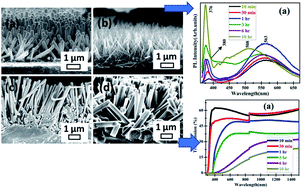ZnO thin film-nanowire array homo-structures with tunable photoluminescence and optical band gap†
Abstract
The growth and optical behavior of ZnO thin film-nanowire array homo-structures is reported. The ZnO films are deposited on glass substrates by thermal evaporation and subjected to heat treatment at 400 °C for 2 h to achieve crystallinity and stoichiometry. The surface comprises spherical grains or elongated flakes depending on thickness of films. These films are introduced in to a hydrothermal reactor in a medium of zinc acetate and HMTA to realize the nanostructures. The process results in the formation of ZnO nanowires with dimensions that are strongly dependent on the surface microstructure of the ZnO films. The role of temperature (90–180 °C) and duration (10 min to 10 h) of hydrothermal processing is investigated in detail. It is demonstrated that low temperature and short duration are ideal for producing nanowires with diameter < 100 nm, while longer durations and higher temperatures lead to large diameter and long length nanowires. Interestingly, all wires converge to a hexagonal shape with increase in duration or temperature. The lowest diameter of the vertically aligned nanowires is 50 nm and length upto 10 μm is achieved. Optical band gap of the homo-structures is of the order of 3.4–3.5 eV. Raman and photoluminescence spectra indicate the presence of defects in the films. The thin films exhibit a strong defect related photoluminescence peak centred around 550 nm. The nanowires grown on the films display both the UV-near band edge peak as well as the defect related peak. However, the intensity of the defect peak decreases with increase in length of the nanowires indicating that the photoluminescence of the homo-structures can be tuned by changing the surface microstructure of the films and also the aspect ratio of the nanowires.



 Please wait while we load your content...
Please wait while we load your content...